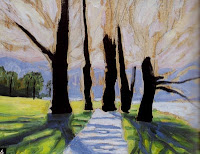An otherwise effective oil painting could be spoiled by a garish tree, a black splodge or a grey expanse of water that is not in keeping with the vibrant colours of the painting. In an attempt to put the painting right, the artist may fiddle with the area, overworking the paint until it looks a muddy mess. How can the painting be put right?
Culprits to Making Mistakes in Oil Painting
 |
Correct an Oil Painting
Rachel Shirley |
Few things are more frustrating for the artist than completing a satisfactory oil painting, except for a particular area. The view holds true that an oil painting is only as good as its weakest point. No matter what the artist does, the offending area of oil paint will continue to draw the eye unintentionally. The undesirable option of scrapping the painting and starting again may seem to be the only option. The following may have brought the artist to this point:
- Completing the painting in one go causing the final part to be rendered when tired or in a rush
- Guesswork an area of painting by trying to paint it from memory, for instance by using green paint neat from the tube for grass or trees
- Trying to work from a poor photograph
- Fiddling too much with an area of the painting, causing the area to lose life and become muddy
- Trying to erase a mistake by adding ever thicker layers of oil paint
- Having insufficient colours within the palette to express the colours required, causing the artist to use substitute colours which are unsatisfactory
- Using cheap brushes, which do not control the paint sufficiently
- Not thinking through the composition properly until the paint has been applied when it is too late
How to Put an Oil Painting Right
Scrapping the painting need not always be the only option, unless the overall painting is unsatisfactory. If only one area is at fault, the following may be worth trying:
If the area is quite large, such as a
lake painting or area of sky, for example, carefully wipe the paint off with a clean soft rag. Keep wiping the area with a clean area of cloth until most of the paint is removed.
With a little linseed oil on a clean rag, wipe the last remnants of the oil paint from the painting surface
Leave the area to dry for two days or so, or until the painting surface is dry
If the offending area of the oil painting has completely dried, the area can be lightly sanded down with fine glass paper to remove any impasto effects and paint ridges until smooth. Using a dust buster or vacuum will prevent the dust from lodging into another area of the painting.
Tonking an Oil Painting
If the offending area is close to an intricate area of detail, the artist may use a method known as “tonking,” named after sir Arthur Tonks, who came up with the idea. It is quite simple and is akin to blotting.
- Cut or tear a piece of clean paper (newspaper will do) into roughly the size and shape of the offending area of the painting
- Place the paper over the area and press down with the palms of the hands
- Gently lift the paper off
- Repeat with more clean paper
- Lift off again
- Repeat until no paint can be seen lifting off with the paper
- The painting can be left to dry over a day or so and new paint can be reapplied over the area
Essential Art Materials for Successful Oil Painting

Mistakes are unavoidable and are part of learning how to oil paint. However, the following will help minimise mistakes from spoiling an otherwise effective oil painting:
- Good quality artist’s resources, such as clear photographs or sketches
- Including the primary colours for colour mixing
- Having good quality sable brushes or bristles
- Stick to recommended oil painting manufacturers such as Winsor & Newton or Daler Ronwey
- Composing the picture properly before applying the paint
When tired or time is running short, don’t rush it, put the painting away. It can be completed the next day.
Links to Advice on Oil Painting

a.jpg)



